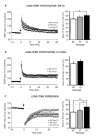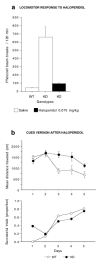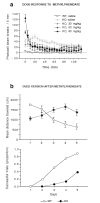Parallel loss of hippocampal LTD and cognitive flexibility in a genetic model of hyperdopaminergia
- PMID: 17342172
- PMCID: PMC2547847
- DOI: 10.1038/sj.npp.1301354
Parallel loss of hippocampal LTD and cognitive flexibility in a genetic model of hyperdopaminergia
Abstract
Dopamine-mediated neurotransmission has been implicated in the modulation of synaptic plasticity and in the mechanisms underlying learning and memory. In the present study, we tested different forms of activity-dependent neuronal and behavioral plasticity in knockout mice for the dopamine transporter (DAT-KO), which constitute a unique genetic model of constitutive hyperdopaminergia. We report that DAT-KO mice exhibit slightly increased long-term potentiation and severely decreased long-term depression at hippocampal CA3-CA1 excitatory synapses. Mutant mice also show impaired adaptation to environmental changes in the Morris watermaze. Both the electrophysiological and behavioral phenotypes are reversed by the dopamine antagonist haloperidol, suggesting that hyperdopaminergia is involved in these deficits. These findings support the modulation by dopamine of synaptic plasticity and cognitive flexibility. The behavioral deficits seen in DAT-KO mice are reminiscent of the deficits in executive functions observed in dopamine-related neuropsychiatric disorders, suggesting that the study of DAT-KO mice can contribute to the understanding of the molecular basis of these disorders.
Figures






References
-
- Arnsten AFT. Catecholamine modulation of prefrontal cortical cognitive function. Trends in Cognitive Sciences. 1998;2:436–446. - PubMed
-
- Arvanov VL, Liang X, Schwartz J, Grossman S, Wang RY. Clozapine and haloperidol modulate N-methyl-D-aspartate- and non-N-methyl-D-aspartate receptor-mediated neurotransmission in rat prefrontal cortical neurons in vitro. J Pharmacol Exp Ther. 1997;283:226–234. - PubMed
-
- Barkley RA. Behavioral inhibition, sustained attention, and executive functions: constructing a unifying theory of ADHD. Psychol Bull. 1997;121:65–94. - PubMed
-
- Berke JD, Hyman SE. Addiction, dopamine, and the molecular mechanisms of memory. Neuron. 2000;25:515–532. - PubMed
Publication types
MeSH terms
Substances
LinkOut - more resources
Full Text Sources
Research Materials
Miscellaneous

